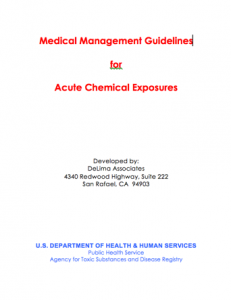Medical Management Guidelines for Acute Chemical Emergencies (MMG)
Purpose
The Agency for Toxic Substances and Disease Registry’s (ATSDR) mission is to prevent or mitigate adverse human health effects and diminished quality of life resulting from exposure to hazardous substances in the environment. ATSDR provides educational and referral resources to health care providers who are responsible for chemically exposed patients. ATSDR contracted with DeLima Associates to prepare Medical Management Guidelines for Acute Chemical Exposures (MMGs), which are chemical specific protocols for managing activities at hazardous materials accidents. This initiative was in response to the Bhopal, India chemical disaster of 1984.
Approach
DeLima Associates staff produced the MMGs in consultation with a peer review committee. The project started with a peer committee meeting in which the format was conceived, content determined, and goals and methodology established. Guest Contributors involved in hazardous materials response and emergency medicine provided the basic information. This information was reviewed by an in-house physician, toxicologist, chemist, and writer with acute care and hazardous materials expertise. In this way, quality assurance was maintained and consistency of tone, format, and medical information was assured. After further in-house editorial review, the document was sent to an expert panel for peer review. Comments and suggestions of this panel were incorporated, and the document was prepared in desktop publishing form. The final draft was then submitted to ATSDR for review and approval.
The protocols for specific chemicals include victim management in the Hot Zone, Decontamination Zone, and Support Zone; field triage; victim management in the Emergency Department, and patient disposition and follow-up. The guidelines are divided into five sections: general information, health effects, pre-hospital management, emergency department management, and patient information. The general information section contains summary information on the chemical’s use and production, health effects, physical properties, and exposure standards. The health effects section outlines the acute effects expected on major organ systems due to exposure to the chemical. Potential sequalae and effects of chronic exposure, including carcinogenicity and reproductive hazards are also reviewed. The pre-hospital management section contains personal protection, decontamination procedures, first aid, and triage recommendations. Emergency department management includes specific antidotes and other treatments for exposed patients
Results
Environmental health specialists, physicians, firefighters, industrial hygienists, environmental health technicians, nurses, and poison control centers use the MMGs when responding to hazardous materials incidents. Victims of hazardous material exposure can use the Patient Information Sheet of the MMG to help them understand their health risks or symptoms and medical care. The information in the guidelines is also useful for the nonemergency activities of occupational health providers, toxicologists, and safety managers.
The American College of Emergency Physicians has distributed over 15,000 copies of the MMGs to their members. Hospitals and fire departments continue to request copies both for reference and for use in training. The National Library of Medicine (NLM) has incorporated the MMGs into WISER, the Wireless Information System for Emergency Responders. WISER is available as a standalone application on MS Windows mobile devices, Palm OS PDAs and MS Windows PCs.
To date, the following 36 individual chemicals have been completely addressed through a 5-part protocol. In addition, an introduction provides a mini training in hazardous materials management:
- Phosgene
- Phosgene Oxime
- Phosphine
- Sodium Hydroxide
- Sulfur Dioxide
- Tetrachloroethylene
- Toluene
- Toluene Diisocyanate
- 1,1,1-Trichloroethane
- Trichloroethylene
- Vinyl Chloride
- Xylene

